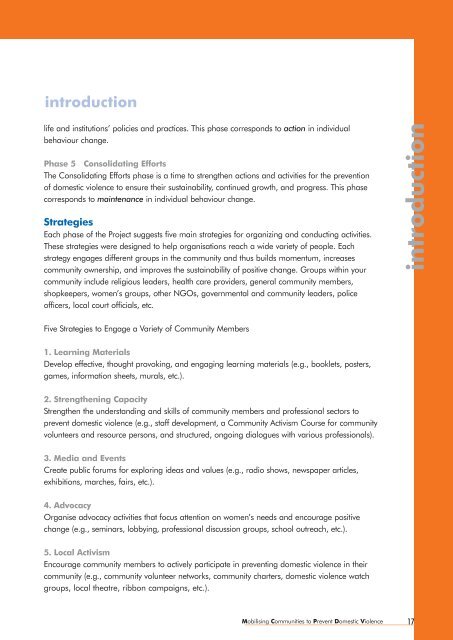Mobilising Communities to Prevent - Raising Voices
Mobilising Communities to Prevent - Raising Voices
Mobilising Communities to Prevent - Raising Voices
- No tags were found...
Create successful ePaper yourself
Turn your PDF publications into a flip-book with our unique Google optimized e-Paper software.
introduction<br />
life and institutions’ policies and practices. This phase corresponds <strong>to</strong> action in individual<br />
behaviour change.<br />
Phase 5 Consolidating Efforts<br />
The Consolidating Efforts phase is a time <strong>to</strong> strengthen actions and activities for the prevention<br />
of domestic violence <strong>to</strong> ensure their sustainability, continued growth, and progress. This phase<br />
corresponds <strong>to</strong> maintenance in individual behaviour change.<br />
Strategies<br />
Each phase of the Project suggests five main strategies for organizing and conducting activities.<br />
These strategies were designed <strong>to</strong> help organisations reach a wide variety of people. Each<br />
strategy engages different groups in the community and thus builds momentum, increases<br />
community ownership, and improves the sustainability of positive change. Groups within your<br />
community include religious leaders, health care providers, general community members,<br />
shopkeepers, women’s groups, other NGOs, governmental and community leaders, police<br />
officers, local court officials, etc.<br />
introduction<br />
Five Strategies <strong>to</strong> Engage a Variety of Community Members<br />
1. Learning Materials<br />
Develop effective, thought provoking, and engaging learning materials (e.g., booklets, posters,<br />
games, information sheets, murals, etc.).<br />
2. Strengthening Capacity<br />
Strengthen the understanding and skills of community members and professional sec<strong>to</strong>rs <strong>to</strong><br />
prevent domestic violence (e.g., staff development, a Community Activism Course for community<br />
volunteers and resource persons, and structured, ongoing dialogues with various professionals).<br />
3. Media and Events<br />
Create public forums for exploring ideas and values (e.g., radio shows, newspaper articles,<br />
exhibitions, marches, fairs, etc.).<br />
4. Advocacy<br />
Organise advocacy activities that focus attention on women’s needs and encourage positive<br />
change (e.g., seminars, lobbying, professional discussion groups, school outreach, etc.).<br />
5. Local Activism<br />
Encourage community members <strong>to</strong> actively participate in preventing domestic violence in their<br />
community (e.g., community volunteer networks, community charters, domestic violence watch<br />
groups, local theatre, ribbon campaigns, etc.).<br />
<strong>Mobilising</strong> <strong>Communities</strong> <strong>to</strong> <strong>Prevent</strong> Domestic Violence<br />
17
















